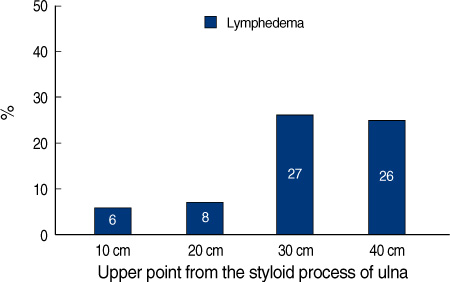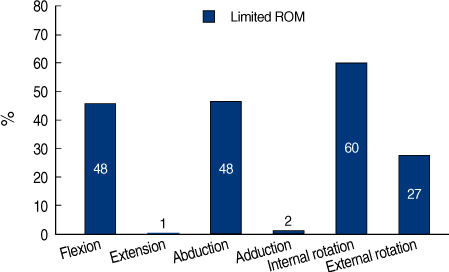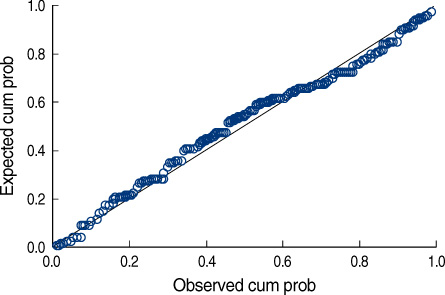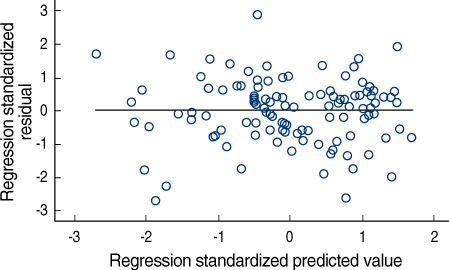Relationships of Lymphedema, the Shoulder Range of Motion, Fatigue and Social Support to the Health Related Quality of Life in Patients with Breast Cancer
- Affiliations
-
- 1Graduate School of Public Health, Ajou University, Suwon, Korea.
- 2Department of Nursing, University of Ulsan, Ulsan, Korea. smoon@ulsan.ac.kr
- 3Kyungpook National University College of Nursing, Daegu, Korea.
- 4Department of Radiation Oncology, Ajou University College of Medicine, Suwon, Korea.
- KMID: 2286548
- DOI: http://doi.org/10.4048/jbc.2010.13.2.212
Abstract
- PURPOSE
The purpose of this study was to identify the variables that are associated with the health related quality of life (HRQOL) for patients with breast cancer.
METHODS
A total of 112 subjects were recruited from a cancer center at a university hospital by using convenience sampling. The subjects were asked to complete questionnaires about HRQOL, fatigue and social support (family and medical team support). A trained research assistant then measured the subjects' shoulder range of motion (ROM) and the arm parameters for lymphedema. The data was analyzed using t-tests, Mann-Whitney tests, ANOVA, Pearson's correlation coefficient and hierarchical multiple regression analysis.
RESULTS
The HRQOL was strongly correlated with fatigue (r=-0.80, p<0.01). It was also positively correlated with family support (r=0.57, p<0.01) and medical team support (r=0.33, p<0.01). The HRQOL was significantly lower for the patients who had limited shoulder rotation. Fatigue and family support together explained 65% of the variance in the HRQOL for the patients with breast cancer, after controlling for education and income. Of them, fatigue uniquely explained 32% of the variance in the HRQOL.
CONCLUSION
Fatigue was the strong predictor of the HRQOL. This result suggests that fatigue might be primary managed for improving the HRQOL of patients with breast cancer.
Keyword
MeSH Terms
Figure
Cited by 4 articles
-
Effects of a 4-Week Multimodal Rehabilitation Program on Quality of Life, Cardiopulmonary Function, and Fatigue in Breast Cancer Patients
Junghwa Do, Youngki Cho, Jaeyong Jeon
J Breast Cancer. 2015;18(1):87-96. doi: 10.4048/jbc.2015.18.1.87.Body Image and Physical suffering during Radiotherapy in Breast Cancer Patients Following Breast Conserving Operations
Mi Ok Han, Jeong Yun Park
Asian Oncol Nurs. 2014;14(3):155-161. doi: 10.5388/aon.2014.14.3.155.Factors that Influence Korean Breast Cancer Patients to Undergo Cancer Rehabilitation Therapy
Hui-jeong Park, Kyunghee Kim, Ji-su Kim
Asian Oncol Nurs. 2015;15(2):106-113. doi: 10.5388/aon.2015.15.2.106.Menopausal Symptoms and Quality of Life Among Breast Cancer Patients with Chemotherapy-induced Amenorrhea
Jin-Hee Park, Yong-Sik Jung, Ji Young Kim, Sun Hyoung Bae, Yujung Jo
Asian Oncol Nurs. 2019;19(2):90-97. doi: 10.5388/aon.2019.19.2.90.
Reference
-
1. Ministry for Health, Welfare and Family Affairs. Annual report of cancer incidence (2005) and survival (1993-2005) in Korea. 2008. Seoul: Ministry for Health, Welfare and Family Affairs.2. Lee EH, Park HB, Kim MW, Kang S, Lee HJ, Lee WH, et al. Analyses of the studies on cancer-related quality of life published in Korea. J Korean Soc Ther Radiol Oncol. 2002. 20:359–366.3. Suh YO. Predictors of quality of life in women with breast cancer. J Korean Acad Nurs. 2007. 37:459–466.
Article4. Kuehn T, Klauss W, Darsow M, Regele S, Flock F, Maiterth C, et al. Long-term morbidity following axillary dissection in breast cancer patient-clinical assessment, significance for life quality and the impact of demographic, oncologic and therapeutic factors. Breast Cancer Res Treat. 2000. 64:275–286.
Article5. Bower JE, Ganz PA, Desmond KA, Bernaards C, Rowland JH, Meyerowitz BE, et al. Fatigue in long-term breast carcinoma survivors: a longitudinal investigation. Cancer. 2006. 106:751–758.6. Lee EH, Chung BY, Park HB, Chun HK. Relationships of mood disturbance and social support to symptom experience in Korean women with breast cancer. J Pain Symptom Manage. 2004. 27:425–433.
Article7. Suh SL. Lee MS, Lee WH, Kim GS, Tae YS, Suh SL, So HS, editors. Cancer patients and social support. Psychosocial Nursing Care and Research for Cancer Patients. 2007. Seoul: Soo-Moon Sa;51–74.8. Coster S, Poole K, Fallowfield LJ. The validation of a quality of life scale to assess the impact of arm morbidity in breast cancer patients post-operatively. Breast Cancer Res Treat. 2001. 68:273–282.
Article9. Stein KD, Jacobsen PB, Blanchard CM, Thors C. Further validation of the multidimensional fatigue symptom inventory-short form. J Pain Symptom Manage. 2004. 27:14–23.
Article10. Tae YS, Kang ES, Lee MH, Park GJ. The relationship among perceived social support, hope and quality of life of cancer patients. Korean J Rehabil Nurs. 2001. 4:219–231.11. Andersen L, Hojris I, Erlandsen M, Andersen J. Treatment of breast-cancer-related lymphedema with or without manual lymphatic drainage--a randomized study. Acta Oncol. 2000. 39:399–405.
Article12. Fleissig A, Fallowfield LJ, Langridge CI, Johnson L, Newcombe RG, Dixon JM, et al. Post-operative arm morbidity and quality of life. Results of the ALMANAC randomized trial comparing sentinel node biopsy with standard axillary treatment in the management of patients with early breast cancer. Breast Cancer Res Treat. 2006. 95:279–293.
Article13. Suh YO. Predictors of quality of life in women with breast cancer. J Korean Acad Nurs. 2007. 37:459–466.
Article14. Ahn SH, Park BW, Noh DY, Nam SJ, Lee ES, Lee MK, et al. Health-related quality of life in disease-free survivors of breast cancer with the general population. Ann Oncol. 2007. 18:173–182.
Article15. Patrick DL, Ferketich SL, Frame PS, Harris JJ, Hendricks CB, Levin B, et al. National Institutes of Health State-of-the-Science Conference Statement: Symptom management in cancer: pain, depression, and fatigue, July 15-17, 2002. J Natl Cancer Inst Monogr. 2004. 32:9–16.16. Byar KL, Berger AM, Bakken SL, Cetak MA. Impact of adjuvant breast cancer chemotherapy on fatigue, other symptoms, and quality of life. Oncol Nurs Forum. 2006. 33:E18–E26.
Article17. Chun MS, Moon SM, Lee HJ, Lee EH, Song YS, Chung YS, et al. Arm morbidity after breast cancer treatments and analysis of related factors. J Korean Soc Ther Radiol Oncol. 2005. 23:32–42.18. Sammarco A. Quality of life among older survivors of breast cancer. Cancer Nurs. 2003. 26:431–438.
Article19. Sammarco A. Quality of life of breast cancer survivors: a comparative study of age cohorts. Cancer Nurs. 2009. 32:347–356.20. Luoma ML, Hakamies-Blomqvist L. The meaning of quality of life in patients being treated for advanced breast cancer:a qualitative study. Psychooncology. 2004. 13:729–739.
Article21. Beaulac SM, McNair LA, Scott TE, LaMorte WW, Kavanah MT. Lymphedema and quality of life in survivors of early-stage breast cancer. Arch Surg. 2002. 137:1253–1257.
Article22. Voogd AC, Ververs JM, Vingerhoets AJ, Roumen RM, Coebergh JW, Crommelin MA. Lymphoedema and reduced shoulder function as indicator of quality of life after axillary lymph node dissection for invasive breast cancer. Br J Surg. 2003. 90:76–81.
Article23. Ververs JM, Roumen RM, Vingerhoets AJ, Vreugdenhil G, Coebergh JW, Crommelin MA, et al. Risk, severity and predictors of physical and phychological morbidity after axillary lymph node dissection for breast cancer. Eur J Cancer. 2001. 37:991–999.
Article24. Ernst MF, Voogd AC, Balder W, Klinkenbjjl JH, Roukema JA. Early and late morbidity associated with axillary levels I-III dissection in breast cancer. J Surg Oncol. 2002. 79:151–155.
Article
- Full Text Links
- Actions
-
Cited
- CITED
-
- Close
- Share
- Similar articles
-
- Comparisons of Physiological and Psychosocial Symptoms for Breast Cancer Patients with and without Lymphedema
- The association of social support and quality of life in gynecological cancer related of lymphedema in a hospital: a pilot study
- Health-Related Quality of Life in Breast Cancer Patients with Lymphedema Who Survived More than One Year after Surgery
- The Impact of Upper Limb Dysfunctions on Quality of Life in Patients with Breast Cancer
- The Effect of Stellate Ganglion Block on Breast Cancer-Related Infectious Lymphedema





